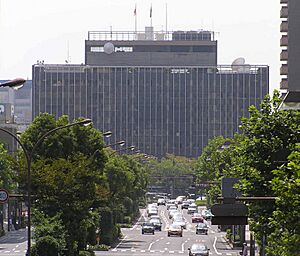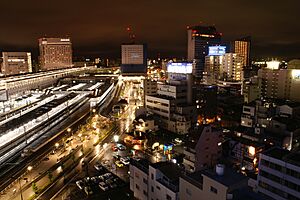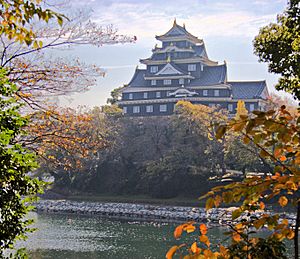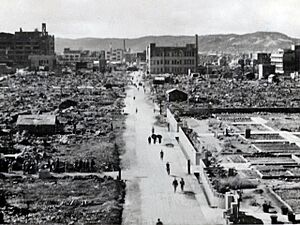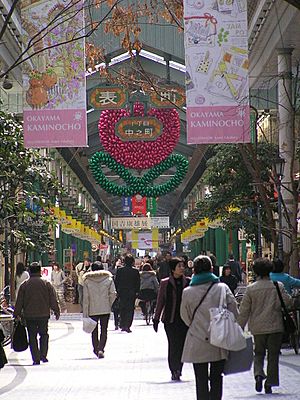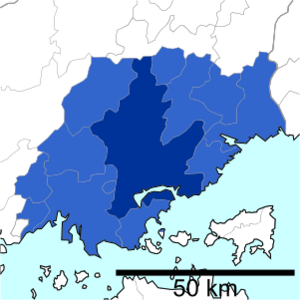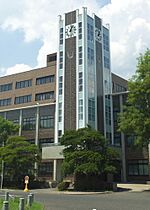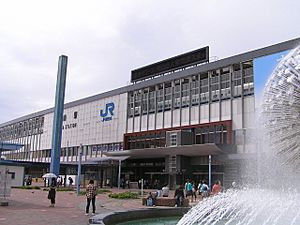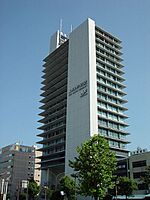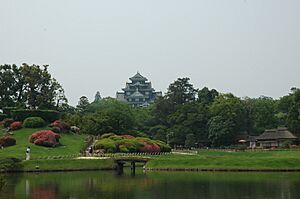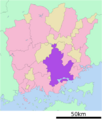Okayama facts for kids
Quick facts for kids
Okayama
岡山市
|
|||||||||||||
|---|---|---|---|---|---|---|---|---|---|---|---|---|---|
| Okayama City | |||||||||||||
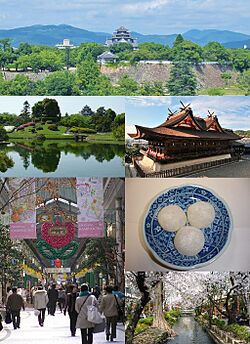
(From top, left to right : Okayama Castle • Okayama Kōraku-en Garden • Kibitsu Jinja • Kibidango • Omote-chō shopping arcade • Nishigawa Green Park)
|
|||||||||||||
|
|||||||||||||
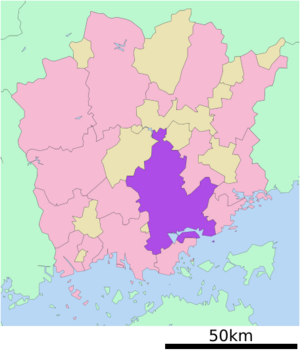 |
|||||||||||||
| Country | Japan | ||||||||||||
| Region | Chūgoku (San'yō) | ||||||||||||
| Prefecture | Okayama | ||||||||||||
| Area | |||||||||||||
| • Total | 789.95 km2 (305.00 sq mi) | ||||||||||||
| Population
(February 1, 2023)
|
|||||||||||||
| • Total | 700,940 | ||||||||||||
| • Density | 887.322/km2 (2,298.153/sq mi) | ||||||||||||
| Time zone | UTC+09:00 (JST) | ||||||||||||
| City hall address | 1-1-1 Daitomo, Kita-ku, Okayama-shi, Okayama-ken 700-8544 | ||||||||||||
|
|||||||||||||
Okayama (岡山市 (Okayama-shi)) is a major city in Japan. It is the capital city of Okayama Prefecture. You can find it in the Chūgoku region of Japan. The area around Okayama City is the biggest place for jobs in western Japan's Chugoku region.
The city was officially started on June 1, 1889. As of February 2023, about 700,940 people live there. This means there are about 890 people per square kilometer. The city covers a total area of 789.95 square kilometers.
Okayama is home to Kōraku-en, which is one of Japan's top three traditional gardens. It also has Okayama Castle, ranked among the best 100 Japanese castles. The city is famous for the Japanese fable Momotarō, a story about a peach boy. In 2016, Okayama joined the UNESCO Global Network of Learning Cities.
Contents
- Okayama's Past: A Look at History
- Okayama's Location and Climate
- Okayama's Economy and What it Produces
- Learning in Okayama: Schools and Universities
- Getting Around Okayama: Transportation
- Okayama's Sister Cities
- Media and News in Okayama
- Sports Teams in Okayama
- Fun Things to See and Do in Okayama
- Famous People from Okayama
- Images for kids
- See also
Okayama's Past: A Look at History
How Okayama Grew: From Farms to a Big City
Long ago, before the Muromachi period, Okayama was mostly farmland. It had a small castle built by the Kanemitsu family. During the Sengoku period, a leader named Ukita Naoie took over Okayama. He saw its great location for transport and its rich farmlands.
Naoie made the castle much bigger and better. He also built a main road, the old Sanyo road, right through the center of the castle town. He invited skilled workers from all over to help build the city. Because of this, Okayama became the main place for politics and business in Bizen Province.
In 1600, Ukita Hideie, Naoie's son and the lord of Okayama, lost an important battle called the Battle of Sekigahara. The next year, Kobayakawa Hideaki became the new lord of Okayama Domain. But Hideaki died in 1602, and his family line ended.
Then, Ikeda Tadatugu, who was the lord of Himeji Domain, took over Okayama. The Ikeda family ruled Okayama for a very long time, until the late 1800s. Okayama kept growing and became one of Japan's ten largest castle towns by the 1700s. The beautiful Korakuen Garden was created by the fourth Ikeda lord, Ikeda Tsunamasa.
Okayama in Modern Times: From Meiji to World War II
In 1871, the new Meiji government in Japan changed how the country was run. They replaced the old feudal system with a central government. Okayama was chosen as the capital of Okayama Prefecture. In 1889, Okayama City was officially founded.
During the Meiji period, new train lines like the San'yo Main Line helped the city grow even more. Important schools were also built here, such as the Sixth Higher Middle School (第六高等学校, Dairoku Kōtōgakkō) and Okayama Medical College (岡山医科大学, Okayama Ika-daigaku). Okayama became a key center for transport and education in western Japan.
When World War II started, Okayama City was a military base for the Imperial Japanese Army. On June 29, 1945, the city was attacked with incendiary bombs. Most of the city was burned down, and over 1,700 people lost their lives. Okayama was badly damaged, with more than 12,000 homes destroyed.
Okayama After World War II: Rebuilding and Growth
After World War II, Japan experienced a big economic boom in the 1960s. Okayama grew quickly during this time. It became one of the most important cities in the Chūgoku and Shikoku regions.
In 1972, the San'yō Shinkansen (bullet train) started service between Shin-Ōsaka and Okayama. Two years later, the Shinkansen line was extended to Hakata. In 1988, the Seto-Ōhashi Bridge opened. This bridge directly connected Okayama with Shikoku by both train and road.
Okayama became a core city in 1996. Then, on April 1, 2009, it became a designated city. This gave the city more power to make its own local decisions.
Over the years, some nearby towns joined Okayama City. On March 22, 2005, the towns of Mitsu and Nadasaki became part of Okayama. Later, on January 22, 2007, the towns of Takebe and Seto also merged with Okayama.
Okayama's Location and Climate
Where is Okayama City Located?
Okayama City is in the southern part of Okayama Prefecture. This prefecture is in the western part of Japan's main island, Honshū. The northern part of the city has gentle hills, which are part of the Kibi Plateau. Here you'll find the Asahikawa Dam, Okayama Airport, and homes outside the city center.
The main city area is on the Okayama Plain in the south. This plain was formed by two major rivers, the Asahi River and Yoshii River. These rivers flow into the Seto Inland Sea. South of the main city is Kojima Bay, which is part of the scenic Kojima Peninsula. This area offers beautiful views of the Seto Inland Sea.
What is Okayama's Weather Like?
Okayama has a mild climate compared to most of Japan. It has the most days with no rain (less than 1mm of precipitation) of any city in Japan. It is the second driest and fourth sunniest city in the Chūgoku region. The climate is known as humid subtropical (Cfa).
The weather is warm enough all year to grow olive trees. Okayama is often called "Land of Sunshine" because it has so few rainy days each year.
| Climate data for Okayama (1991−2020 normals, extremes 1891−present) | |||||||||||||
|---|---|---|---|---|---|---|---|---|---|---|---|---|---|
| Month | Jan | Feb | Mar | Apr | May | Jun | Jul | Aug | Sep | Oct | Nov | Dec | Year |
| Record high °C (°F) | 18.8 (65.8) |
22.3 (72.1) |
24.8 (76.6) |
29.6 (85.3) |
33.6 (92.5) |
37.0 (98.6) |
38.1 (100.6) |
39.3 (102.7) |
37.1 (98.8) |
33.4 (92.1) |
26.9 (80.4) |
21.5 (70.7) |
39.3 (102.7) |
| Mean daily maximum °C (°F) | 9.6 (49.3) |
10.5 (50.9) |
14.6 (58.3) |
19.8 (67.6) |
24.8 (76.6) |
27.6 (81.7) |
31.8 (89.2) |
33.3 (91.9) |
29.1 (84.4) |
23.4 (74.1) |
17.1 (62.8) |
11.7 (53.1) |
21.1 (70.0) |
| Daily mean °C (°F) | 4.6 (40.3) |
5.2 (41.4) |
8.7 (47.7) |
14.1 (57.4) |
19.1 (66.4) |
22.7 (72.9) |
27.0 (80.6) |
28.1 (82.6) |
23.9 (75.0) |
18.0 (64.4) |
11.6 (52.9) |
6.6 (43.9) |
15.8 (60.4) |
| Mean daily minimum °C (°F) | 0.1 (32.2) |
0.5 (32.9) |
3.5 (38.3) |
8.5 (47.3) |
14.8 (58.6) |
18.7 (65.7) |
23.4 (74.1) |
24.6 (76.3) |
20.0 (68.0) |
13.4 (56.1) |
6.8 (44.2) |
2.1 (35.8) |
11.4 (52.5) |
| Record low °C (°F) | −8.9 (16.0) |
−9.1 (15.6) |
−7.0 (19.4) |
−3.6 (25.5) |
1.0 (33.8) |
7.4 (45.3) |
12.6 (54.7) |
14.8 (58.6) |
7.2 (45.0) |
1.7 (35.1) |
−3.5 (25.7) |
−6.5 (20.3) |
−9.1 (15.6) |
| Average precipitation mm (inches) | 36.2 (1.43) |
45.4 (1.79) |
82.5 (3.25) |
90.0 (3.54) |
112.6 (4.43) |
169.3 (6.67) |
177.4 (6.98) |
97.2 (3.83) |
142.2 (5.60) |
95.4 (3.76) |
53.3 (2.10) |
41.5 (1.63) |
1,143.1 (45.00) |
| Average snowfall cm (inches) | 0 (0) |
1 (0.4) |
0 (0) |
0 (0) |
0 (0) |
0 (0) |
0 (0) |
0 (0) |
0 (0) |
0 (0) |
0 (0) |
0 (0) |
1 (0.4) |
| Average precipitation days (≥ 0.5 mm) | 5.4 | 6.9 | 9.2 | 9.6 | 9.4 | 11.6 | 10.9 | 7.7 | 9.7 | 7.7 | 6.4 | 6.3 | 100.8 |
| Average relative humidity (%) | 69 | 66 | 65 | 60 | 64 | 71 | 74 | 69 | 71 | 71 | 72 | 71 | 69 |
| Mean monthly sunshine hours | 149.0 | 145.4 | 177.8 | 192.6 | 205.9 | 153.5 | 169.8 | 203.2 | 157.5 | 171.5 | 153.7 | 153.8 | 2,033.7 |
| Source: Japan Meteorological Agency | |||||||||||||
Okayama's Economy and What it Produces
Farming in Okayama
Okayama City is located on the Okayama Plain, which is great for farming. Farmers here grow rice, eggplant, and white Chinese chives. In the hillier northern parts of the city, you'll find delicious white peaches and grapes.
Okayama's Industries
In 2005, the city's total economic output was 800 billion yen. This was almost 10% of the entire Okayama Prefecture's economy. The larger Okayama area, including nearby cities, had an economy worth about US$63.1 billion in 2010.
The main industries in Okayama are machine tools, chemicals, food production, and printing. Kōnan, a district in the southern part of the city, is the most developed industrial area.
Shopping and Business in Okayama
Okayama is the main business center for the larger Okayama area. This includes the cities of Kurashiki and Sōja. The main shopping areas are Omotechō, which is close to Okayama Castle and Kōraku-en, and the area around Okayama Station. Omotechō has many covered shopping streets.
The main office of Aeon Corporation, a large English language school, is also located in Okayama.
Learning in Okayama: Schools and Universities
Okayama is home to Okayama University, a national university. It started as a medical school in 1870 and became a full university in 1949. Today, it's the biggest university in Okayama, with many different departments and graduate schools.
The city also has seven private universities and three junior colleges. For younger students, there are 24 high schools (16 public, 8 private), seven combined junior high/high schools, 38 junior high schools, and 93 elementary schools.
Universities in Okayama
- Okayama University (national)
- Notre Dame Seishin University (private)
- Okayama Healthcare Professional University (private)
- Okayama University of Science (private)
- Okayama Shoka University (private)
- Sanyo Gakuen University (private)
- Shujitsu University (private)
- Chugoku Gakuen University (private)
- International Pacific University (private)
High Schools in Okayama
- Okayama Joto Senior High School
- Okayama Ichinomiya Senior High School
- Okayama Asahi Senior High School
- Okayama Sozan Senior High School
- Okayama Hosen Senior High School
- Okayama Gakugeikan High School
Getting Around Okayama: Transportation
Airports Near Okayama
- Okayama Airport is in the northern part of the city. It has flights within Japan and some international flights.
- Kōnan Airport, located to the south, is now used for general aviation. This means it's for smaller, private planes, since Okayama Airport opened in 1988.
Train Travel in Okayama
Okayama Station is a very important train hub for JR West. Trains from Shikoku, Sanin, and San'yo all connect here to the San'yō Shinkansen (bullet train).
Local train lines that serve Okayama Station include: ![]() JR West – San'yō Shinkansen
JR West – San'yō Shinkansen
- Okayama
- Mantomi – Seto – Joto – Higashi-Okayama – Takashima – Nishigawara – Okayama – Kitanagase – Niwase
- Saidaiji – Odara – Higashi-Okayama
- Okayama – Omoto – Bizen-Nishiichi – Senoo – Bitchū-Mishima – (Hayashima Town - Kurashiki City) – Hikosaki – Bizen-Kataoka – Hazakawa
- Uematsu
- Okayama – Hōkaiin – Bizen-Hara – Tamagashi – Makiyama – Nonokuchi – Kanagawa – Takebe – Fukuwatari
- Okayama – Bizen-Mikado – Daianji – Bizen-Ichinomiya – Kibitsu – Bitchū-Takamatsu – Ashimori
Okayama's Tram System
Okayama still has a working tram system that has been around since the Meiji period. It is run by Okayama Electric Tramway. There are two lines: the Higashiyama Main Line and the Seikibashi Line.
Bus Services in Okayama
Seven different bus companies provide service within Okayama City: Bihoku Bus (備北バス), Chūtetsu Bus (中鉄バス), Okaden Bus (岡電バス), Ryōbi Bus (両備バス), Shimoden Bus (下電バス), Tōbi Bus (東備バス), and Uno Bus (宇野バス).
Okayama's Sister Cities
Okayama has special partnerships with cities around the world. These are called sister cities:
 San Jose, California, United States (since May 26, 1957)
San Jose, California, United States (since May 26, 1957) San José, Costa Rica, (since January 27, 1969)
San José, Costa Rica, (since January 27, 1969) Plovdiv, Bulgaria, (since April 28, 1972)
Plovdiv, Bulgaria, (since April 28, 1972) San Antonio, Texas, United States (since April 12, 1976)
San Antonio, Texas, United States (since April 12, 1976) Luoyang, China, (since April 6, 1981)
Luoyang, China, (since April 6, 1981) Bucheon, Gyeonggi-do, South Korea (friendship city since 2002)
Bucheon, Gyeonggi-do, South Korea (friendship city since 2002) Hsinchu, Taiwan (friendship city since 2003)
Hsinchu, Taiwan (friendship city since 2003)
Media and News in Okayama
The Sanyo Shimbun is the local newspaper for the greater Okayama area. There are also six television stations that serve Okayama and parts of Kagawa Prefecture. Three FM and three AM radio stations broadcast in the region.
- TV stations
| Channel ID | Name | Network | Established year | Call sign |
|---|---|---|---|---|
| 1 | NHK General TV Okayama | NHK General TV | 1957 | JOKK-DTV |
| 2 | NHK Educational TV Okayama | NHK Educational TV | 1963 | JOKB-DTV |
| 4 | Nishinippon Broadcasting Co., Ltd.(RNC) | NNN | 1958 | JOKF-DTV |
| 5 | Setonaikai Broadcasting Co., Ltd.(KSB) | ANN | 1969 | JOVH-DTV |
| 6 | Sanyo Broadcasting Co., Ltd. (RSK) | JNN | 1958 | JOYR-DTV |
| 7 | TV Setouchi Broadcasting Co., Ltd. (TSC) | TXN | 1985 | JOPH-DTV |
| 8 | Okayama Broadcasting Co., Ltd. (OHK) | FNN | 1969 | JOOH-DTV |
- Radio stations
| Channel | Name | Network | Established year | Call sign |
|---|---|---|---|---|
| AM 603 kHz | NHK Radio Daiichi Okayama | NHK Radio Daiichi | 1931 | JOKK |
| AM 1386 kHz | NHK Radio Daini Okayama | NHK Radio Daini | 1946 | JOKB |
| AM 1494 kHz | Sanyo Broadcasting Co, Ltd. Radio (RSK) | JRN, NRN | 1958 | JOYR |
| FM 88.7 MHz | NHK FM Okayama | NHK FM | 1964 | JOKK-FM |
| FM 76.8 MHz | FM Okayama | JFN | 1999 | JOVV-FM |
| FM 79.0 MHz | Radio MOMO (Okayama City FM) | J-WAVE | 1997 | JOZZ8AD-FM |
Sports Teams in Okayama
Okayama is home to several sports teams. In recent years, the volleyball team Okayama Seagulls and the football club Fagiano Okayama have become well-known. In 2009, Fagiano Okayama FC moved up to the J. League, which is Japan's top football league.
| Club | Sport | League | Venue | Established |
|---|---|---|---|---|
| Fagiano Okayama FC | Football | J. League Division 2 | Kanko Stadium (Okayama Prefectural Multipurpose Athletic Stadium) | 2004 |
| Okayama Seagulls | Volleyball | V.League | Momotaro Arena (Okayama Prefectural Multipurpose Grounds Gym) | 1999 |
| Okayama Standing Bears | American football | X-League | Kanko Stadium (Okayama Prefectural Multipurpose Athletic Stadium) | ? |
| Citylight Okayama Baseball Team | Baseball | Semi-professional baseball | 2008 |
Fun Things to See and Do in Okayama
- Kōraku-en: This is one of Japan's three best traditional gardens. It's located south of Okayama Castle. Ikeda Tsunamasa built it over 14 years, finishing in 1700.
- Handayama Botanical Garden: A beautiful garden with many different plants.
- Okayama Castle: Built in 1597, this castle was destroyed during World War II bombings in 1945. But it was rebuilt in 1966 and looks amazing today.
- Okayama Prefectural Museum: A museum where you can learn about the history and culture of Okayama.
- Okayama Orient Museum: This museum displays art and artifacts from the Middle East.
- Okayama Prefectural Museum of Art: Here you can see various artworks.
- Hayashibara Museum of Art: Another art museum with interesting collections.
- Yumeji Art Museum: Dedicated to the works of artist Yumeji Takehisa.
- Kibitsu Shrine: An important and historic shrine.
- Kibitsuhiko Shrine: Another significant shrine in the area.
- Okayama Symphony Hall: A place where you can enjoy musical performances.
Important Historical Sites in Okayama
Okayama has many places that are protected as National Historic Sites:
- Urama Chausuyama Kofun
- Okayama Castle
- Okayama Domain Ikeda clan cemetery
- Former Okayama Domain Han School
- Bitchū-Takamatsu Castle
- Shōda temple ruins
- Magane Ichirizuka
- Jingūjiyama Kofun
- Sōzume Tō
- Tsukuriyama Kofun
- Ōmeguri-Komeguri Mountain Castle ruins
- Ōdara Yosemiya ruins
- Tsushima Site
- Hata temple ruins Pagoda Site
- Onoe Kurumayama Kofun
- Hikozaki Shell Mound
- Mantomi Tōdai-ji Tile Kiln Site
- Musa Ōtsuka Kofun
Festivals and Music in Okayama
Every August since 1994, Okayama hosts the Momotarō Matsuri (Festival). This festival combines three different celebrations, including the Uraja 'ogre' festival, which features a lively Yosakoi dance.
The Okayama Symphony Orchestra performs at the Okayama Symphony Hall. Also, Inryō-ji, a Buddhist temple near the city center, often holds concerts.
What to Eat in Okayama: Local Dishes
Okayama has some delicious traditional foods. Barazushi (error: {{nihongo}}: Japanese or romaji text required (help)) is a sushi rice dish with fresh fish from the Seto Inland Sea. Kibi dango (Okayama) (吉備団子) are sweet, gel-like balls made from millet and rice powder. They are a very famous treat from the area.
Famous People from Okayama
Okayama has been home to many talented people throughout history.
People from the Arts
- Shigeru Nanba (painter, born 1944)
- Takashi Fukutani (manga artist, 1952–2000)
- Masashi Kishimoto (manga artist, born 1974)
- Seishi Kishimoto (manga artist, born 1974)
Writers and Authors
- Suiin Emi (novelist, 1869–1934)
- Yōko Ogawa (novelist, born 1962)
- Hyakken Uchida (novelist, 1889–1971)
- Junnosuke Yoshiyuki (novelist, 1924–1994)
Entertainers and Performers
- Angela Aki (singer-songwriter, born 1977) - she went to middle school in Okayama.
- Dorlis (musician, born 1982)
- Hiroto Kōmoto (musician, born 1963)
- Shinji Morisue (former gymnast and TV personality, born 1957)
- Matsunosuke Onoe (actor and film director, 1875–1926)
- Etsuko Shihomi (actress, born 1955)
- Yukiko Takaguchi (voice actor, born 1974)
- Tomu Uchida (film director, 1898–1970)
- Riki Nishimura (member of the K-pop boy group Enhypen, born 2005)
- MISA (Bassist for Band-Maid, born October 15)
- Miku Nishizaki (member of Ocha Norma, born 2006)
- Fujii Kaze (singer-songwriter, born June 14, 1997)
Sports Stars
- Tsunenohana Kan'ichi (sumo Yokozuna, born 1896)
- Noboru Akiyama (baseball player and coach, 1934–2000)
- Yuko Arimori (athlete, born 1966)
- Naoko Hashimoto (volleyball player, born 1984)
- Shigeaki Hattori (racing driver and team owner, born 1963)
- Kinue Hitomi (athlete, 1907–1931)
- Masahiro Kawai (baseball player, born 1964)
- Issei Morita (baseball player, born 1989)
- Maurice Ndour (born 1992) (Senegalese basketball player)
- Hikaru Sato (wrestler and mixed martial artist, born 1980)
- Hinako Shibuno (golfer, born 1998)
- Kiyoshi Tamura (wrestler, born 1969)
- Hisashi Tsuchida (soccer player, born 1967)
Inventors from Okayama
- Seiichi Miyake (inventor of tactile paving, 1926–1982)
Images for kids
See also
 In Spanish: Okayama para niños
In Spanish: Okayama para niños





